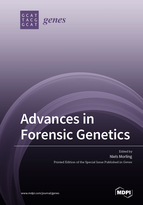Advances in Forensic Genetics
A special issue of Genes (ISSN 2073-4425). This special issue belongs to the section "Molecular Genetics and Genomics".
Deadline for manuscript submissions: closed (15 December 2021) | Viewed by 127892
Special Issue Editor
2. Department of Mathematical Sciences, Aalborg University, Aalborg, Denmark
Interests: forensic genetics; genetics of sudden cardiac death; biostatistics
Special Issue Information
Dear colleagues,
Forensic Genetics has—mainly due to the advent of modern DNA technologies—undergone an impressive development leading to exciting possibilities in forensic genetic work with criminal cases, relationship testing, identification of human remains, animal and plant forensics, etc. This Special Issue is dedicated to the presentation of the current status of forensic genetics and discussion of future challenges and goals through invited presentations. Colleagues are encouraged to submit manuscripts with original research in forensic genetics.
Prof. Dr. Niels Morling
Guest Editor
Manuscript Submission Information
Manuscripts should be submitted online at www.mdpi.com by registering and logging in to this website. Once you are registered, click here to go to the submission form. Manuscripts can be submitted until the deadline. All submissions that pass pre-check are peer-reviewed. Accepted papers will be published continuously in the journal (as soon as accepted) and will be listed together on the special issue website. Research articles, review articles as well as short communications are invited. For planned papers, a title and short abstract (about 100 words) can be sent to the Editorial Office for announcement on this website.
Submitted manuscripts should not have been published previously, nor be under consideration for publication elsewhere (except conference proceedings papers). All manuscripts are thoroughly refereed through a single-blind peer-review process. A guide for authors and other relevant information for submission of manuscripts is available on the Instructions for Authors page. Genes is an international peer-reviewed open access monthly journal published by MDPI.
Please visit the Instructions for Authors page before submitting a manuscript. The Article Processing Charge (APC) for publication in this open access journal is 2600 CHF (Swiss Francs). Submitted papers should be well formatted and use good English. Authors may use MDPI's English editing service prior to publication or during author revisions.
Keywords
- Forensic genetics
- Criminal cases
- Relationship testing
- Human identification
- Animal forensic genetics
- DNA
- RNA
- Short Tandem Repeats (STR)
- Single Nucleotide Polymorphism (SNP)
- Mitochondrial DNA (mtDNA)
- Massively Parallel Sequencing (MPS)
- Forensic statistics
- Ethics in forensic genetics







